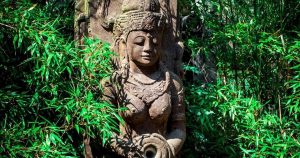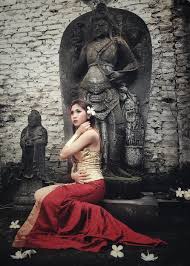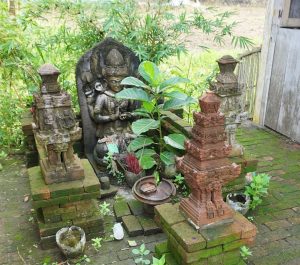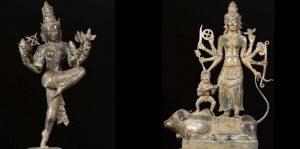
In India, the temples called devalaya or vimana. In Bali they are called pura. Why are temples in Java called candi?
Candi means ‘old throne’ and is one of the names of Durga (known as Sang Hyang Bathari Durga in Java), the Mother Goddess, who is born from the Cosmic energy to save the world threatened of destruction by the demons. She is called Chandika, Ambika or Durga.
She was especially venerated by the Javanese common people, who brought offerings to her, whereas the kings and aristocracy venerated the Shiva linga in the most sacred part of the temple. With time, her name, Candi, became the generic name for the temple itself.
She was so popular in Indonesia that the Museum Nasional in Jakarta today has 32 Durga statues. More are regularly discovered. At least 135 ancient statues of Durga have been found in Java, where she is known by the common people as Loro Jonggrang (“slender maiden”). The most famous temple in Java is the Candi Lara Jonggan of Prambanan, where a murti of Durga stands in the northern niche.
Durga is the wife of Sada Shiva. Durga in Java is exclusively found in candis dedicated to Shiva.
Sang Hyang Bathari Durga today is worshiped either as Tara or under her manifestation as the Queen of the South Seas, Nyai Lara Kidul.

A manifestation of Shakti
In Hindu cosmology, Durga is one of the manifestations of Adi Parashakti (shortened as Shakti), the female cosmic energy that creates and supports the visible world. Shakti is worshiped in order to maintain the cycles of life and to attain enlightenment and deliverance.
Shakti can take on the form of various goddesses in the Hindu and Buddhist pantheon. She alternatively appears as Durga, Parvati, Lakshmi and Tara. All the goddesses are endowed with a variety of attributes and special powers. The fierce and destructive form of Shakti is Durga Mahisasuramardini (literally ‘the one who crushes Asura Mahisa’ (the demon with a buffalo appearance)) .
The most important Purana related to the stories of the Great Goddess is the Devi Mahatmya, which is part of the Markandeya Purana. Rishi Markandeya was one of the great sages who first brought this knowledge to Sumatra, Java and Bali.

The majority of Durga statues show a very serene figure. Durga often smiles and has her eyes half closed as in meditation.
But in her fierce form as Mahisasuramardini, Durga is the fierce protector of the world, expressing the fearsome aspects of divine forces. An inscription mentions that King Airlangga went into the forest to worship Durga in order to win her support in an upcoming battle.
Durga is usually represented with a high headdresses, lots of jewellery and multiple arms.
The fierce (krodha) form of Durga is the consort of Shiva in his wrathful form, called Bhairava. Durga in her dreadful form is also called Kali, with a sacred cord made from skulls, wild hair and sharp teeth. Within the Kala Bhairava branch of Shaivism in Java, Durga transformed into this fearful goddess.
Evidence from Javanese relief carvings and scriptures tells us about Durga’s appearance and interaction with her worshipers, and the immense power she has over the life and death of humans and in the world.

Durga in the holy scriptures
The word Durga in Sanskrit literally means “impassable”, “invincible, unassailable”, “beyond defeat”. It is related to the Sanskrit root durg which means “fortress, something difficult to defeat or pass”.
The word Durga appears in the most ancient scriptures of humanity, such as the Rig Veda [hymns 4.28, 5.34, 8.27, 8.47, 8.93] and in sections 10.1 and 12.4 of the Atharvaveda. She is also mentioned in section 2.451 of the Mahabharata and section 4.27.16 of the Ramayana.
Durga is further described in the Devi Mahatmya, the Markandeya Purana and the Devi-Bhagavata Purana. The Devi Upanishad and other Shakta Upanishads also contain the philosophical and mystical aspects of Durga as Devi, identifying her to be the same as Brahman.
One of the most important texts of Shaktism is the Devi Mahatmya, which celebrates Durga as the Supreme Being and the Creator of the Universe. The Devi Mahatmya is considered by Shakta Hindus to be as important as the Bhagavad Gita.
‘’I have created all worlds at my will without being urged by any higher Being, and dwell within them. I permeate the earth and heaven, and all created entities with my greatness and dwell in them as eternal and infinite consciousness.’’ — Devī sūkta, Rigveda 10.125.8

Navadurga: the 9 Forms of
Goddess Durga
The Navadurgā (‘Nine forms of Durga’) are the nine manifestations of Durga, who is especially worshiped during Navratri, when each of the nine forms is venerated respectively each night: Shailaputri, Brahmacharini, Chandraghanta, Kushmanda, Skandamata, Kaalratri, Katyayani, Mahagauri and Siddhidhatri.
Each manifestation of Durga is known by her respective name, governing planet, iconography, mantra for invocation (usually repeated 108 times at each sitting during the period of Navratri), dedication day for Navratri and respective prayers.
Credits to – https://medium.com/@Kalpavriksha/sang-hyang-bathari-durga-the-mother-goddess-and-the-javanese-candi-ccc9a5ebf421
Please consider Donating to keep our culture alive

